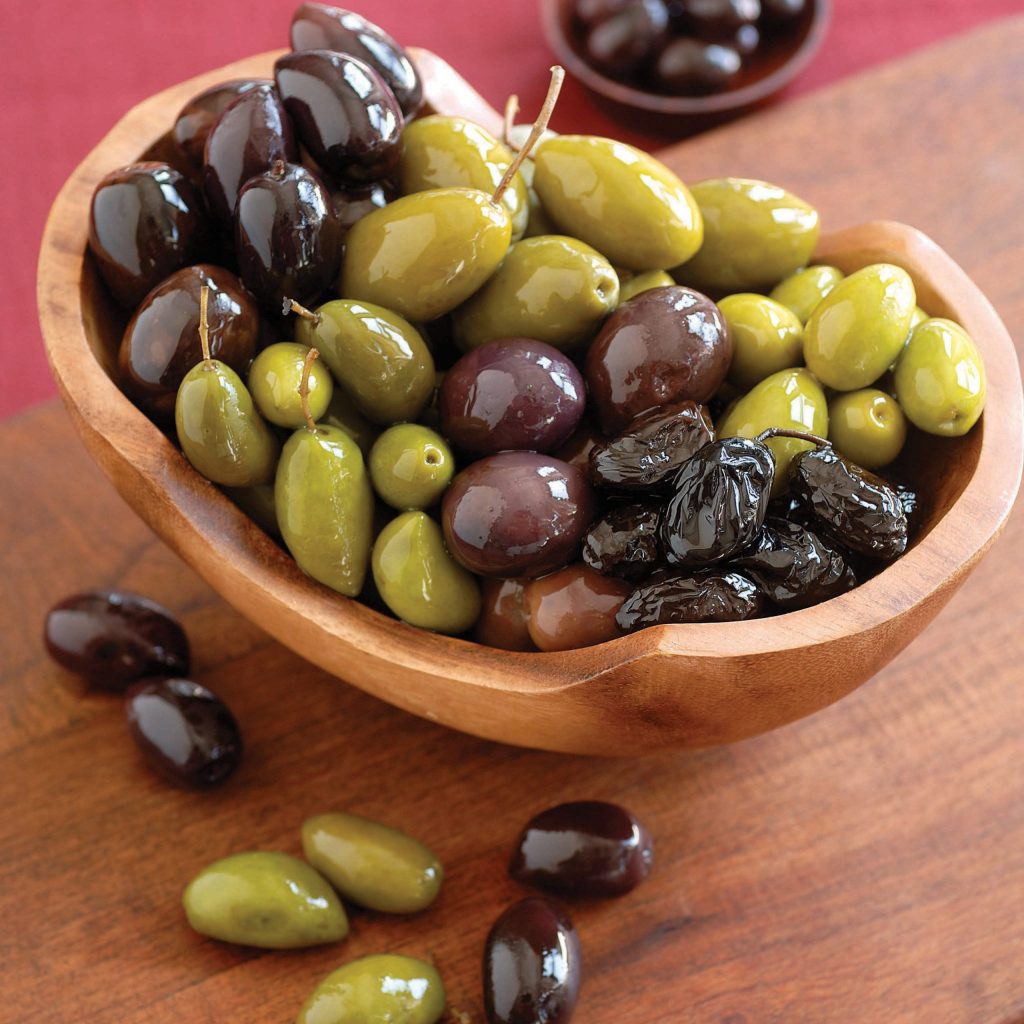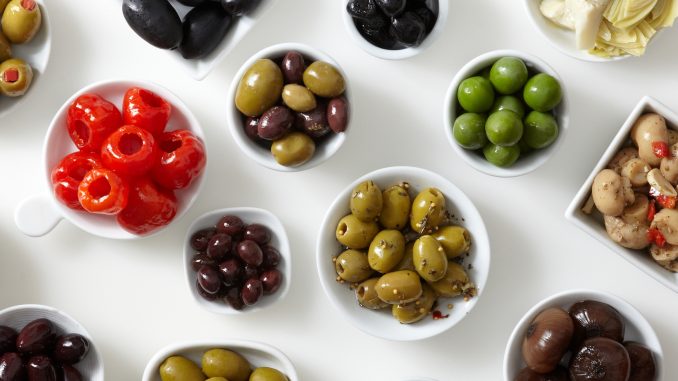A Secret Deli Weapon
February 1, 2020 | 5 min to read
Olives have evolved from simple canned options to a diverse culinary staple, experiencing a 179 percent rise in global consumption over the past three decades. As consumers become more sophisticated and health-conscious, the demand for creatively presented olives in antipasti and snack formats increases. Today, olives are sourced globally, with a particular appreciation for varieties from Tunisia and Morocco, enhancing dishes and contributing to the Mediterranean diet which emphasizes healthy, plant-based eating.

Olives are easy to love. Their symphony of sweet, sour, salty, bitter and pungent flavors are uniquely complex, making them an essential ingredient for any food lover. Yet, just a few decades ago, your average shopper had a pretty narrow view of olives. Some were green, some were black, some were pitted and the best ones were pimento-stuffed, and that was that. They usually came in cans, or if they were fancy, in jars.
Today’s more food savvy consumers are hungry for a wider array of olives. From elaborate to antipasti and olive bars to packages marinated with citrus and spices, olives are sold and presented in increasingly creative ways. Global olive consumption has grown by about 179 percent over the past three decades, according to data from the International Olive Council., head- quartered in Madrid, Spain.
“Olives continue to be an impactful and growing category for deli and spe- cialty,” says Brandon Gross, vice president of marketing at New York City-based FOODMatch. “While many programs, ours included, have expanded and diversi- fied into grab-and-go packaging formats, we are still seeing excitement and growth around the olive and antipasti bar. We attribute this to a few things—product innovation, the ability to customize and control portions and a desire to cook simple and healthful meals using unique, prepared ingredients.” As customers become more educated and passionate about ingredients, health and quality, olive sales benefit.
Tradition Meets Innovation
Olives are anything but new. In fact, olive trees are some of the oldest trees ever harvested by humans, a practice that dates back more than 8,000 years. In recent years, there’s been an olive renaissance. “Olive sales are definitely increasing,” says Jeffrey Siegel, CEO of Farm Ridge Foods, headquartered in Islandia, NY. “People are getting more sophisticated in their taste—their palates are getting more exploratory—and as they try new olives, often with charcuterie or antipasti, they really like what they discover.”
Traditionally, olives come from the Mediterranean. Today, olive production spans the globe; great wine regions and cli- mates tend to be hospitable to olive trees, too. Most domestic olives come from California, and olives also thrive in Latin America and other subtropical zones. “Consumers are loving blends from all parts of the world, like Tunisia, Morocco and Brazil,” says Siegel.
Olive trees grow quite slowly and also require meticulous cultivation. In exchange for that intensive investment, their longev- ity rewards many generations in the future. They live long, long lives—some for as much as a millennium.
Olives are incredibly versatile. Snacking is always a great option but olives also add a pop of briny flavor to salads, pizza, pasta and beyond. Green olives lend depth to chicken thighs, roasted with tomatoes and topped with Feta. And Kalamata olives are perfect in pasta with rosemary, chickpeas and a generous glug of extra-virgin olive oil. They can be ground into tapenades, sauces and spreads. They’re a great accompani- ment to cheese and charcuterie platters.
May is International Mediterranean Diet Month, but the Mediterranean way of eating and thinking about food proves to be healthy all year long. The Mediterranean way of eating means enjoying mostly plantbased foods, like fresh fruits and veggies, whole grains, fish and nuts. It also means using healthy, monounsaturated fats like olive oil and whole olives, too. After all,
olive trees have been flourishing throughout Greece since about 3,000 B.C.

Good and Good for You
Olives are packed with healthy fats. Of the 1.5 grams of fat in a 15-gram serving of olives, more than 75 percent is monoun- saturated. These healthy monounsaturated fatty acids are associated with decreased risk of heart disease, reduced risk of chronic disease, lower blood pressure and more far-reaching health benefits. These healthy fats may also aid in weight loss. Plus, they help consumers feel satisfied while being relatively low in calories.
Olives are rich in polyphenols, which fight oxidative stress and may protect against diseases and certain types of cancer. Olives are full of Vitamin E, a powerful antioxidant, which may help with skin and hair health and protect from neurological disorders. Plus, they’re rich in vitamin A, an antioxidant that’s essential for protecting the cornea and keeping our eyes healthy. Vitamin A may help prevent age-related eye problems like macular degeneration, cataracts and glaucoma.
Tariffs and Olive Sales
A conflict with the European Union over aircraft carriers has led to a long list of proposed tariffs on goods from European countries. As of Oct. 18, 2019, imports of
certain types of Spanish and French olives received a 25 percent tariff. This espe- cially impacted Spanish olives, which had already been hurt by an earlier round of tariffs imposed in 2018. (Spain’s southern Andalusia region is home to the world’s largest olive oil and olive industry.) Spanish producers are feeling the squeeze, and their businesses are struggling. At press time, olive imports from other countries in the EU and around the world are not affected, but that could change at any time.
Understandably, fear of tariffs lingers. They threaten to injure everyone along the supply chain, from importers and dis- tributors to retailers and customers. The resulting price increases would make imported olives inaccessible to the gen- eral consumer. Retailers would no longer be able to stock these items, and shoppers would be unwilling or unable to foot the significantly higher price tag.
Olive bars, full of different colors of treats and unique finds, can be an enticing way to display olives and attract consumers but they’re not without their challenges. Maintaining a well-kept olive bar requires a lot of store real estate and resources, like constant cleaning, rotation and supervision. The price in labor and attention can be steep. “We’re definitely seeing a push away from olive bars towards pre-pack- aged olives,” Farm Ridge’s Siegel explains. He sees olive bars as most successful in busy, high-traffic stores.
Thinking Beyond the Olive Bar
“For us, it’s less about identifying a most successful packaging format and more about ensuring we’re offering the right for- mats for all customers,” FOODMatch’s Gross weighs in. His goal is to meet the consumer where their comfort level is, whether that’s the olive bar, a prepacked cup, snack pack or glass jar. “Our job is to understand which products are most appropriate for their respective pack and understand the nuances in how each cus- tomer uses the product,” he explains. “At the end of the day, no matter what packag- ing format somebody purchases, our job is to give them consistent, delicious ingredi- ents that spark joy and satisfaction.”
First and foremost, a high-quality prod- uct speaks for itself. “We want a shopper to look at our product and immediately make the connection to our mission, val- ues and quality. And of course, layered on top of that is communicating simple and interesting ways to use the products in the kitchen,” Gross says. “Don’t just sell the olive…sell the joyful experience and memorable meal that the olive will be a part of.” DB
4 of 7 article in DeliBusiness Feb/Mar 2020

